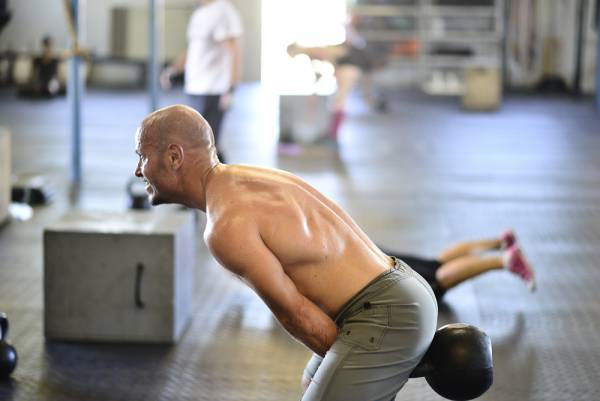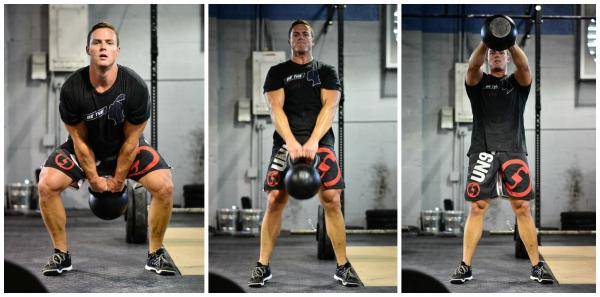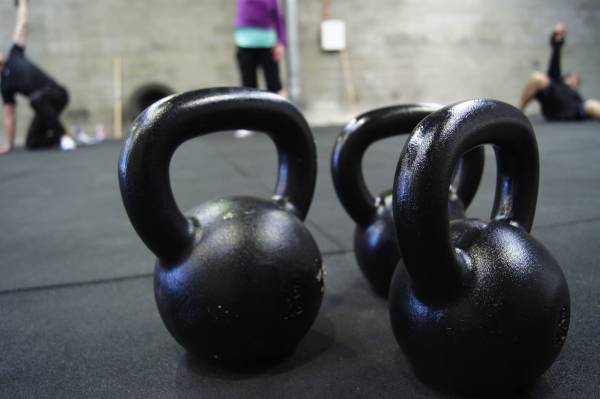When it comes to lifting things to get stronger, there is little difference between one tool and another. The body doesn’t recognize the tool, only how hard it has to work to lift whatever it is you’re holding.
Therefore, a solid strength-training plan for a barbell should be transferrable to kettlebells and vice versa. Having said that, there are some things a kettlebell is extremely good for, as well as some smarter ways to put them in your programming.
Here’s a list of the top five sins of kettlebell programming and how to counter them in your own training.
Doing Isolation Movements
Nothing makes me more infuriated than when I see someone doing a “kettlebell” workout that includes triceps kickbacks, bicep curls, and lateral raises. Yes, you can use a kettlebell for those movements, but they’re not good choices. Far better choices for kettlebell exercises are whole-body compound lifts such as the clean and press or clean and jerk, or higher-rep ballistic movements like the swing or snatch.
“For some gym skills, YouTube will work just fine, but for kettlebells? Not so much.”
The real goal when training kettlebells is to work movements and not muscles. Every single exercise in the RKC system (done correctly) is a whole-body exercise. By teaching the body to link together and become one piece, rather than act like a Frankenstein-like assemblage of multiple parts, you will be far more suited to many athletic tasks than if you spend your time doing isolation training. Many big names in training science such as Stuart McGill have done some amazing research pointing out just how incredible kettlebells can be for whole body training if used correctly.
Using Two Kettlebells for Everything
One of the great things about kettlebells is the way they allow people who may not have the mobility to use barbells to still do pressing in their workouts. Two kettlebells give you more space to move around and find a position that suits you than a barbell does.

But if you’re like most people, and you’re more than just a little stiff or tight, one kettlebell works even better. Training on one side provides a lot of wiggle room to fit your body around the bell. This allows even those who might not be able to train bilaterally at all to still get in some decent work.
“The real goal when training kettlebells is to work movements and not muscles.”
If you look at all the main kettlebell certifications – RKC, SFG, and the new Strength Matters certification – they are all single bell at level one. While you may think that is too easy, a single bell forces you to constantly work hard to fight rotation and prove you are stable and in control. Many find some movements even harder with a single bell – for example, squatting holding the bell in the rack on only one side – than they do working with doubles, which tend to balance you out.
The single bell ties in well with what I think of as the dual goals of kettlebell training – strength and movement. While you may gain more strength by training with two bells, the single bell forms a solid platform for FMS-based strength training. In fact, single-bell training is the quickest way I’ve yet seen to address the four fundamental patterns of the screen (active straight leg raise, shoulder mobility, trunk stability push up, and rotary stability).
Doing Your Strength and Conditioning Separately
One of the great things about kettlebells is the ability to combine strength and conditioning into the same routine. But I often see bad programming that has strength work performed first and conditioning work done last. The idea behind this is that you aren’t too fatigued for the strength part of the workout.
A well-programmed kettlebell workout ties both these facets together, though. Much like how the body works. There is a seamless interaction within the body from lifting something up off the ground once and continuing to move it for a period of time. The systems of the body just do what is needed to allow you to do the work.
A great example of this is a workout like Dan John’s 10,000 Swing Workout, which combines hundreds of swings per session with low-rep strength moves like pressing or squatting. For time-poor people this approach can help them achieve a lot with a relatively low time investment.

Learning Off YouTube
The information age is amazing. Like many, I have spent my share of time on YouTube trying to learn simple tasks. For some gym skills, YouTube will work just fine, but for kettlebells? Not so much.
The kettlebell doesn’t move like a barbell or a pair of dumbbells. Those pieces just move in a single plane. Kettlebells move up and down, but also in and out, and many exercises have a strong anti-rotational component to them, too. Trying to learn kettlebells off YouTube is about as successful for most people as trying to learn martial arts the same way.
“Worry about movement quality before you worry about movement quantity.”
A much smarter first step would be to book a few private training sessions with an RKC or SFG or to attend one of the one-day courses developed to teach people how to use kettlebells the right way. Don’t be fooled by some of these courses, either. In Australia, there are a few that attempt to teach every kettlebell movement under the sun in one workshop and the end result is you’ll see a bunch of things but walk away barely able to do any of them well.
It is far better to learn a few of the big exercises well. Focus on learning the big six – swing, get up, squat, clean, press, and snatch. As Bruce Lee said, “I don’t fear the man who has done a thousand techniques once. I fear the man who has done one technique a thousand times.”
Expecting Quick Progress
Barbells allow you the opportunity to micro-load and add small percentages of weight at a time. You can easily find 0.25kg plates to use for Olympic bars, making the smallest jump only 500g at a time. But with kettlebells, the smallest jump available will be 2kg. On a smaller kettlebell – like an 8kg – going to the next size up may seem like “only 2kg,” but if you do the math that represents a 25% increase in load. That’s a huge leap.

For this reason, be prepared to use the same kettlebells for long periods before you truly earn that next jump. Personally, I like that people need to stick at one weight for a long time as I know it forces all the unseen parts of the body, such as the ligaments and joints, to adapt to the training. The muscles always adapt more quickly and this can put an unwary trainee at risk of injury.
Earn your progress to the next bell size by making sure you own the previous weight and can perform the movement with great form. Worry about movement quality before you worry about movement quantity.
Be Without Kettlebell Sin
As you may have noticed, the theme of quality over quantity runs through most all of these “kettlebell sins.” If you’re not experiencing the results you want in your training, look to see if you’re committing one of these errors and make the corrections necessary.
Check out these related articles:
- Eradicating Stupidity – a Podcast With Coach Andrew Read
- 100s of Free Kettlebell Workouts
- All You Need to Know About Starting With Kettlebells
- What’s New On Pulse Beat Fit Today
Photos 1-3 courtesy of CrossFit Empirical.
Photo 4 courtesy of Andrew Read.






